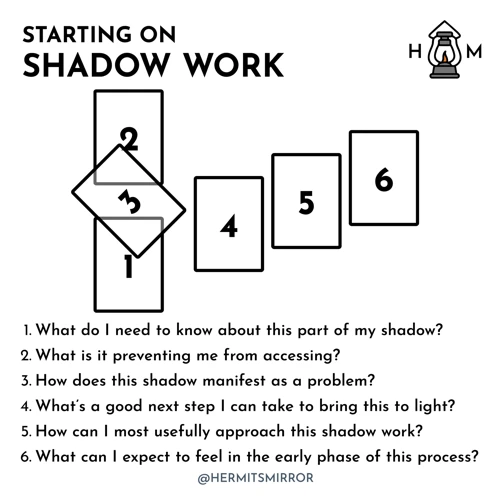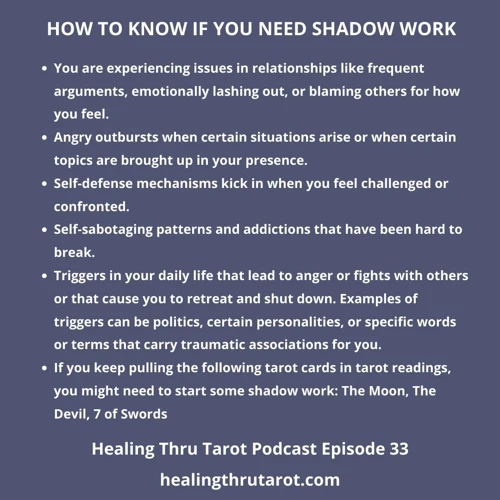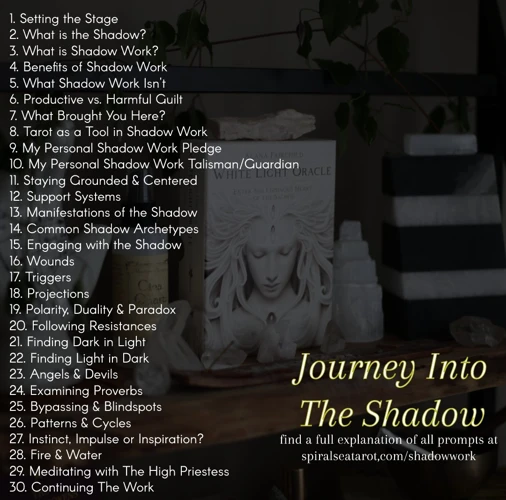Welcome to a journey into the depths of the soul. In the realm of Tarot, there exists a powerful tool for self-exploration and healing known as Shadow Work. This enigmatic concept delves into the hidden aspects of our psyche, uncovering our fears, doubts, and unresolved emotions. By embracing the shadow, we can gain profound self-awareness, personal growth, and spiritual transformation. In this article, we will explore the concept of Shadow Work in Tarot, understanding its significance, how it relates to the Tarot archetypes, and the steps to engage in this transformative process. Join us as we delve into the mysteries of the shadow and unlock the potential for inner healing and self-discovery.
Contents
- What is Shadow Work?
- How Shadow Work Relates to Tarot
- Steps to Engage in Shadow Work with Tarot
- The Benefits of Shadow Work in Tarot
- Common Challenges in Shadow Work
- Conclusion
-
Frequently Asked Questions
- What is the purpose of Shadow Work?
- How does Tarot relate to Shadow Work?
- Can Shadow Work be challenging?
- Is it necessary to have experience with Tarot to do Shadow Work?
- How do I start practicing Shadow Work with Tarot?
- Can Shadow Work help with personal growth?
- What are some common challenges in Shadow Work?
- Is Shadow Work a form of therapy?
- How long does Shadow Work take?
- Can Shadow Work lead to spiritual transformation?
- References
What is Shadow Work?

Shadow Work is a profound and transformative process that involves exploring the hidden and often repressed aspects of ourselves. It refers to the practice of diving into our unconscious mind, where our fears, traumas, and unhealed wounds reside. The term “shadow” comes from Carl Jung’s psychological concept, which suggests that our unconscious mind holds elements of our personality that we have disowned or rejected.
In the context of Tarot, Shadow Work involves using the Tarot cards as a tool for self-reflection and exploration. It allows us to bring the subconscious to light, illuminating the shadows within us. This practice invites us to confront our shadow self, examine our limiting beliefs, and acknowledge the parts of ourselves that we find difficult to embrace.
Shadow Work is a deeply profound and introspective journey that can lead to personal growth, self-awareness, and healing. By working through our shadows, we can integrate these aspects into our conscious awareness and ultimately experience spiritual transformation. The process of Shadow Work with Tarot is a powerful and transformative path to self-discovery, where we can heal and reintegrate our fragmented selves.
Understanding Shadows in Tarot
In Tarot, shadows represent the hidden aspects of ourselves that often go unnoticed or repressed. They symbolize the parts of our personality that we may find difficult to acknowledge or accept. Understanding shadows in Tarot is essential for engaging in shadow work and utilizing the Tarot cards as a tool for self-reflection and exploration.
The Tarot deck is rich in symbolism, and each card represents different archetypes and aspects of the human experience. Some cards embody light and positivity, while others delve into the depths of our shadows. These shadow cards can reveal our fears, desires, traumas, and unresolved emotions.
An effective way to understand shadows in Tarot is to pay attention to the cards that evoke discomfort or stir up strong emotions. These may include cards like the Tower, Death, or the Devil, which often explore themes of disruption, transformation, and our shadow selves. By acknowledging and examining these cards with Tarot shadow integration, we can confront our shadows, understand their influence on our lives, and begin the healing process.
Importance of Shadow Work
Shadow Work holds immense importance in our personal and spiritual development. It allows us to dive deep into our unconscious mind, illuminating the aspects of ourselves that we tend to overlook or deny. By acknowledging and embracing our shadows, we embark on a journey of self-discovery and healing.
One of the key reasons why Shadow Work is crucial is that it brings awareness to our hidden patterns, fears, and traumas. Often, these aspects of ourselves manifest in our lives in destructive ways, hindering our growth and happiness. By shining a light on these shadows, we can uncover the root causes of our challenges and work towards healing them.
Shadow Work also helps us to cultivate self-compassion and acceptance. As we explore the depths of our psyche, we realize that our shadows are simply parts of ourselves that need love, understanding, and integration. When we embrace these aspects, we become more whole and authentic, allowing us to live more fully.
Shadow Work allows us to break free from the limitations and conditioning imposed by society, family, and culture. By confronting our shadows and questioning our beliefs, we can explore our true selves and live in alignment with our values and desires.
How Shadow Work Relates to Tarot

Shadow Work and Tarot share a deep and inherently intertwined connection. The Tarot deck consists of archetypal symbols and images that mirror the various aspects of the human experience, including the shadow self. Here’s how Shadow Work relates to Tarot:
Exploring the Tarot Archetypes:
Tarot cards represent a range of archetypes, which are universal patterns or energies that reside within the collective unconscious. These archetypes symbolize different aspects of the human psyche, including light and shadow attributes. By delving into the Tarot archetypes, we can gain insights into our own shadows and uncover hidden aspects of the self. For example, cards like The Devil or The Tower can represent themes of fear, transformation, and ego dissolution, inviting us to confront our shadows head-on.
Using Tarot for Self-Reflection:
Tarot cards act as a mirror, reflecting back to us the hidden parts of ourselves. When we engage in Tarot readings for self-reflection, we can ask specific questions that shed light on our shadow aspects. The imagery and symbolism on the cards provide a framework for exploring our subconscious patterns, fears, and desires. Through the process of interpretation and introspection, we can uncover the deeper meanings behind the cards and gain greater awareness of our shadow self.
Tarot serves as a powerful tool for Shadow Work, allowing us to navigate and explore the depths of our psyche while providing guidance and clarity along the way. It offers a visual and symbolic language that invites us to confront our shadows, embrace our authentic selves, and embark on a transformative journey of self-discovery.
Exploring the Tarot Archetypes
When engaging in Shadow Work with Tarot, it is essential to explore the Tarot archetypes. The Tarot deck is rich in symbolism and contains a wide range of archetypal figures and themes that mirror aspects of the human experience. These archetypes, such as the Fool, the Magician, the High Priestess, and the Devil, represent different facets of our psyche.
By delving into the Tarot archetypes, we can gain a deeper understanding of our own inner dynamics and patterns. Each card in the Tarot deck embodies specific energies and qualities that we can recognize within ourselves. Through introspection and contemplation, we can identify which archetypes resonate with our shadows and explore the lessons they hold.
The Tarot archetypes serve as a metaphorical language, offering a bridge between our conscious and unconscious mind. They provide us with insights into our fears, desires, and hidden motivations. By engaging with these archetypes during Shadow Work, we can unravel the layers of our psyche and bring awareness to the aspects of ourselves that need healing and integration.
Discover more about Tarot archetypes and their role in Shadow Work here.
Using Tarot for Self-Reflection
is a powerful and effective way to engage in Shadow Work. Tarot cards serve as mirrors, reflecting back to us the depths of our subconscious mind and providing insights into our hidden aspects. When we engage in self-reflection with Tarot, we open ourselves up to a deeper understanding of our emotions, thoughts, and patterns of behavior.
The symbolism and archetypes present in Tarot cards act as gateways to our unconscious, allowing us to tap into the collective wisdom inherent in these ancient divination tools. Each card carries its own energy and message, providing us with guidance and illumination as we navigate our inner world.
Through Tarot, we can ask specific questions or simply draw cards intuitively to explore our subconscious mind. The images, symbols, and meanings of the cards can be interpreted and applied to our own experiences, shedding light on the aspects of ourselves that we need to examine and heal. Tarot serves as a bridge between our conscious and unconscious mind, enabling us to access insights and truths that may have been buried or overlooked.
Steps to Engage in Shadow Work with Tarot

| Step 1: Acknowledging the Shadow Self |
| Begin by acknowledging that everyone has a shadow self, and it’s a natural part of being human. Take a moment to reflect on the aspects of yourself that you tend to hide or deny. Use the Tarot cards to bring these hidden aspects to the surface, seeking a deeper understanding and acceptance. |
| Step 2: Embracing the Shadow Self |
| Embrace your shadow self without judgment or fear. Recognize that these aspects are a part of you and have valuable lessons to teach. Use the Tarot to explore the symbolism, imagery, and messages associated with these shadow aspects. Embrace them with compassion and curiosity as you delve deeper into self-discovery. |
| Step 3: Examining the Shadow in Tarot Readings |
| During Tarot readings, consciously bring your attention to any cards or themes that evoke feelings of discomfort, resistance, or unease. These may be indicators of your shadow aspects at play. Use the Tarot as a mirror to examine these aspects more closely. Explore the symbolism and messages of the cards to gain insight into the hidden parts of yourself. |
Engaging in Shadow Work with Tarot requires patience, self-reflection, and a willingness to embrace your shadows. By following these steps, you can begin to bring your unconscious fears, desires, and beliefs into the light of consciousness. Through this process, Tarot becomes a powerful tool for self-exploration, healing, and integration.
Step 1: Acknowledging the Shadow Self
Acknowledging the Shadow Self is the first crucial step in engaging in Shadow Work with Tarot. It involves recognizing, accepting, and embracing the parts of ourselves that we tend to disown or disregard. This step requires honesty and vulnerability as we confront our fears, insecurities, and dark aspects within.
Here are some key points to consider in the process of acknowledging the shadow self:
- Self-Reflection: Take time to reflect on your behaviors, emotions, and patterns that you may have been avoiding or suppressing. This introspective practice helps to bring awareness to the aspects of your shadow self.
- Journaling: Keep a journal to document your thoughts and feelings as you explore your shadow. Writing can act as a therapeutic tool, allowing you to express and process your emotions in a safe space.
- Engaging in Inner Dialogue: Have an honest conversation with yourself, asking questions such as: What aspects of myself do I judge or reject? What fears do I have? What triggers me or makes me uncomfortable?
Remember, acknowledging the shadow self is a brave and courageous act. It is an essential step towards self-acceptance and growth. By shining light on these hidden aspects, we can begin the journey of healing and integration.
Step 2: Embracing the Shadow Self
Once we have acknowledged the presence of our shadow self, the next step in Shadow Work with Tarot is to embrace it. Embracing the shadow self involves accepting and loving the parts of ourselves that we have shunned, repressed, or denied. It requires us to step out of judgment and see these aspects as valuable and necessary for our growth and wholeness.
Embracing the shadow self can be challenging and uncomfortable, as it means confronting our deepest fears, insecurities, and vulnerabilities. However, it is through this process of embracing and integrating the shadow that we can experience profound healing and transformation.
When working with Tarot, we can use specific cards or spreads that relate to the shadow aspects of ourselves. These cards can serve as mirrors, reflecting back to us the parts of our being that we need to embrace. Through careful examination and contemplation, we can identify the lessons and gifts that the shadow self has to offer.
Embracing the shadow self is a powerful act of self-compassion and self-acceptance. It is about integrating all aspects of ourselves, both light and dark, and recognizing that they are an essential part of our wholeness. By embracing the shadow, we can move towards self-empowerment, inner harmony, and transformation.
Step 3: Examining the Shadow in Tarot Readings
Once we have acknowledged and embraced our shadow self, the next step in Shadow Work with Tarot is to examine the shadow in Tarot readings. This step involves using the Tarot cards as a mirror to reflect our subconscious patterns, fears, and desires.
Begin by selecting a Tarot spread or layout that focuses specifically on shadow work. You may choose a spread that explores your hidden fears, shadow aspects, or patterns that need healing. As you lay out the cards, allow yourself to connect with your intuition and the energy of the cards.
As you examine each card, pay attention to any emotions or sensations that arise within you. The imagery and symbolism depicted in the cards can act as a catalyst for introspection and self-reflection. Look for cards that resonate with your shadow aspects, unresolved emotions, or underlying beliefs that may be holding you back.
Take note of any recurring themes or patterns that emerge from the cards. Are there specific cards that consistently appear in relation to your shadow? What insights do they offer about the aspects you need to work on? Are there any cards that reveal a potential path of healing and integration?
Remember, the Tarot is a tool of self-discovery and guidance. It is essential to approach the cards with an open mind and heart, allowing the messages they offer to guide you on your shadow work journey. Take your time to contemplate the messages, journal your thoughts, and seek deeper meanings beyond the surface of the cards.
Continue to the next step, Step 4: Integrating the Shadow Self.
The Benefits of Shadow Work in Tarot

Engaging in Shadow Work with Tarot can have profound benefits for personal growth, self-awareness, and spiritual transformation.
1. Personal Growth and Self-Awareness: Shadow Work allows us to bring to light the hidden aspects of ourselves, enabling us to gain a deeper understanding of our fears, patterns, and unconscious motivations. This heightened self-awareness empowers us to make conscious choices and break free from self-limiting beliefs.
2. Healing and Integration: By actively exploring our shadows, we can heal unresolved trauma, emotional wounds, and past hurts. The Tarot cards act as mirrors, reflecting our innermost truths and facilitating the integration of these fragmented parts of ourselves. This process leads to greater self-acceptance, self-love, and inner healing.
3. Spiritual Transformation: Through Shadow Work, we embark on a transformative journey that opens the doors to spiritual growth and enlightenment. By integrating our shadows, we become more aligned with our authentic selves and connect deeply with our spiritual essence. This integration allows us to tap into our inner wisdom and experience profound spiritual transformation.
Shadow Work in Tarot offers a path to self-discovery, healing, and self-realization. As we embrace the shadows within, we unlock the full potential of our being and embark on a journey of self-transformation.
Personal Growth and Self-Awareness
Personal growth and self-awareness are two of the most significant benefits of engaging in Shadow Work with Tarot. As we delve into the depths of our shadows, we uncover hidden aspects of ourselves that have been suppressed or ignored. This process allows us to gain a deeper understanding of our fears, insecurities, and patterns of behavior that may be holding us back.
By shining a light on our shadows, we can develop a heightened sense of self-awareness. We become more conscious of our thoughts, emotions, and actions, and how they influence our daily lives. This increased self-awareness empowers us to make more informed choices and decisions.
Personal growth is a natural outcome of Shadow Work. As we confront and integrate our shadows, we begin to heal the wounds and traumas that have been buried within us. This healing process enables us to grow and evolve on a spiritual and emotional level. We become more whole and integrated individuals, embracing all aspects of ourselves with love and acceptance.
Healing and Integration
One of the significant benefits of Shadow Work in Tarot is the potential for healing and integration. By confronting and working through our shadow aspects, we open the doors to deep inner healing. Shadow Work allows us to acknowledge and address the wounds and traumas that may have been buried within our subconscious. This process brings these issues to the surface, allowing us to give them the attention and healing they deserve.
Through Tarot, we can gain insight into the root causes of our pain and understand the patterns that have kept us stuck. The cards act as mirrors, reflecting back to us the hidden aspects of ourselves that require healing. Each card carries its own symbolism, archetypes, and messages that we can interpret and relate to our own experiences.
Integration is a key component of Shadow Work. It involves embracing and integrating the shadow aspects that we have denied or rejected. Integration does not mean erasing or getting rid of these aspects; instead, it means accepting and making peace with them. By acknowledging and integrating our shadows, we can achieve a sense of wholeness and inner balance.
Shadow Work allows us to dismantle the barriers we have built to protect ourselves, enabling us to experience true healing and transformation. Through this process, we can release the emotional baggage, limiting beliefs, and self-sabotaging behaviors that have held us back.
The healing and integration that come from engaging in Shadow Work with Tarot can lead to a greater sense of well-being, inner peace, and personal empowerment.
Spiritual Transformation
Spiritual transformation is a profound result of engaging in Shadow Work with Tarot. As we explore the depths of our shadow and shine a light on our hidden aspects, we embark on a journey of self-discovery and spiritual growth. Here are some key aspects of the spiritual transformation that can occur through Shadow Work:
- Expanded Consciousness: By delving into our shadows, we expand our awareness and gain a deeper understanding of ourselves. We become more conscious of our patterns, conditioning, and behaviors that may have been operating from our unconscious mind. This expanded consciousness allows us to make more conscious choices and lead a more authentic life.
- Integration and Wholeness: Through Shadow Work, we learn to embrace our shadow self and integrate it into our being. We no longer see our shadows as something to be feared or rejected, but rather as a necessary part of our wholeness. This integration brings a sense of inner balance and harmony.
- Transcendence of Ego: Shadow Work helps us transcend the limitations of the ego by breaking down our false identities and facades. By examining our shadows, we come face to face with our insecurities, fears, and illusions. This process allows us to peel away the layers of the ego and connect with our true essence.
- Connection to the Divine: As we navigate the depths of the shadow, we open ourselves to a deeper connection with our spiritual selves and the divine. Through the process of self-reflection and uncovering our hidden truths, we align ourselves with a higher power and gain a sense of spiritual connection and purpose.
Read more about the benefits of Shadow Work in Tarot and discover how engaging in this transformative practice can lead to personal growth and self-awareness.
Common Challenges in Shadow Work
- Fear of the Unknown: Engaging in Shadow Work can be intimidating as it requires us to face our deepest fears, traumas, and insecurities. The unknown aspects of our psyche can be overwhelming, causing fear and resistance to delve into the shadows. It takes courage to confront these hidden parts of ourselves and explore the uncomfortable terrain of our subconscious.
- Resistance and Denial: The ego often resists the process of Shadow Work, as it prefers to maintain a sense of control and protect itself from discomfort. Denial may surface, leading us to avoid or dismiss our shadows. However, without acknowledging and working through these aspects, true growth and healing cannot occur.
Fear of the Unknown
Fear of the unknown is a common challenge that arises when embarking on the journey of Shadow Work. As humans, we are naturally inclined to seek comfort and familiarity, and stepping into the realm of the unknown can be unsettling.
One of the main reasons for this fear is the uncertainty that comes with exploring hidden aspects of ourselves. We may be afraid of what we might uncover or how it will impact our perception of ourselves and our lives. This fear stems from the belief that delving into our shadows may unearth painful memories, traumatic experiences, or aspects of ourselves that we have avoided dealing with.
It is important to recognize that this fear is natural and understandable. However, facing the unknown can be a catalyst for personal growth and transformation. By confronting our fears and stepping into the darkness, we can gain a deeper understanding of ourselves and ultimately find healing and integration.
One way to overcome the fear of the unknown is to approach it with curiosity and an open mind. Viewing the shadows as opportunities for growth and self-discovery can help shift our perspective and reduce resistance. It is also helpful to seek support from a therapist, counselor, or a trusted friend who can provide guidance and assistance on this journey.
Resistance and Denial
When engaging in Shadow Work, it is not uncommon to encounter resistance and denial. Our ego and subconscious mind often try to protect us from confronting painful or uncomfortable aspects of ourselves. This resistance can manifest in various ways, hindering our progress in the healing journey.
One common form of resistance is the fear of facing the unknown. Our minds are wired to seek safety and familiarity, so when we start delving into the depths of our shadows, it can trigger feelings of insecurity and vulnerability. We may resist exploring certain aspects of ourselves because we are afraid of what we may discover.
Denial is another obstacle in Shadow Work. Our ego may try to suppress, ignore, or dismiss our shadows, hoping that they will simply go away. We may convince ourselves that we have already dealt with these issues or that they are not significant. However, by denying our shadows, we perpetuate their power over us and deny ourselves the opportunity for growth and healing.
To overcome resistance and denial in Shadow Work, it is essential to approach the process with compassion and acceptance. We must be willing to face our fears and acknowledge the parts of ourselves that we have hidden away. This requires a deep commitment to personal growth and a willingness to confront our shadows head-on.
By embracing the challenges of resistance and denial in Shadow Work, we can begin to dismantle the barriers that prevent us from fully integrating our shadows and experiencing profound healing.
Conclusion
In conclusion,
Shadow Work in Tarot is a profound and transformative process that allows us to explore the hidden aspects of ourselves, confront our fears, and integrate our shadow self. By using Tarot as a tool for self-reflection, we can gain deep insights into our unconscious mind, unlocking the potential for personal growth and healing. This practice of embracing our shadows and examining them through the lens of the Tarot archetypes enables us to develop self-awareness and achieve spiritual transformation.
Engaging in Shadow Work can be challenging, as it requires us to face our fears, acknowledge our vulnerabilities, and push past our resistance. However, the benefits far outweigh the difficulties. Shadow Work allows us to heal and integrate the fragmented parts of ourselves, leading to a sense of wholeness and empowerment.
So, are you ready to embark on this transformative journey of self-discovery and exploration? Embrace the shadows within, and let the Tarot guide you on a path towards personal growth and spiritual awakening.
Frequently Asked Questions
What is the purpose of Shadow Work?
The purpose of Shadow Work is to explore and integrate the hidden aspects of ourselves, allowing us to heal, grow, and achieve greater self-awareness.
How does Tarot relate to Shadow Work?
Tarot works as a tool for Shadow Work by providing symbols and archetypes that reflect our unconscious patterns, making it easier to explore and understand our shadow selves.
Can Shadow Work be challenging?
Yes, Shadow Work can be challenging as it requires us to face uncomfortable emotions, confront our fears, and delve into parts of ourselves that we may have avoided or denied.
Is it necessary to have experience with Tarot to do Shadow Work?
No, prior experience with Tarot is not necessary. Shadow Work can be done using Tarot as a guide, but the process itself is about exploring your own psyche and emotions.
How do I start practicing Shadow Work with Tarot?
To begin practicing Shadow Work with Tarot, start by familiarizing yourself with the meanings of the cards and their corresponding archetypes. Then, use the cards to reflect on your own personal experiences, emotions, and shadows.
Can Shadow Work help with personal growth?
Absolutely! Shadow Work is a powerful tool for personal growth as it helps us uncover and integrate the hidden aspects of ourselves, leading to greater self-awareness, healing, and transformation.
What are some common challenges in Shadow Work?
Common challenges in Shadow Work include fear of facing the unknown, resistance to acknowledging our shadows, and the tendency to deny or project our own darkness onto others.
Is Shadow Work a form of therapy?
Shadow Work is not a replacement for therapy, but it can be a complementary practice. It allows us to delve into our subconscious and work on aspects of ourselves that may have been neglected or repressed.
How long does Shadow Work take?
The duration of Shadow Work varies for each individual. It is an ongoing process that unfolds at its own pace, depending on the depth of exploration and the willingness to embrace and integrate the shadows.
Can Shadow Work lead to spiritual transformation?
Yes, Shadow Work has the potential to lead to spiritual transformation by bringing us closer to our authentic selves, helping us release limiting beliefs, and guiding us towards a deeper connection with our spirituality.






